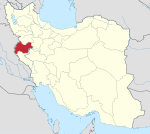Related Research Articles

Kermanshah Province is one of the 31 provinces of Iran and one of the provinces which border Iraq. The province was known from 1969 to 1986 as Kermanshahan, and from 1986 to 1995 as Bakhtaran. The capital of the province is the city of Kermanshah. According to a 2014 segmentation by the Ministry of Interior, it is the center of Region 4, with the region's central secretariat located in Kermanshah. A majority of people in Kermanshah Province are Shia, and there are Sunni and Yarsani minority groups.
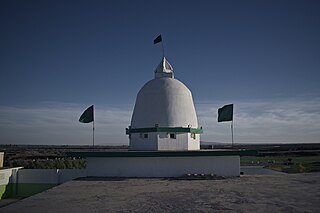
Yarsanism, Ahl-e Haqq, or Kaka'i, is an inherited, syncretic religion founded by Sultan Sahak in the late 14th century in western Iran. The total number of followers of Yarsanism is estimated to be over half a million to one million in Iran. The numbers in Iraq are unknown. Followers are mostly Kurds from the Guran, Sanjâbi, Kalhor, Zangana and Jalalvand tribes. Turkic-speaking Yarsan enclaves also exist in Iran.

Ravansar is a city in the Central District of Ravansar County, Kermanshah province, Iran, serving as capital of both the county and the district.

Kermanshah, is the capital of Kermanshah Province, located 525 kilometres from Tehran in the western part of Iran. According to the 2016 census, its population is 946,651.
Sonqor is a city in the Central District of Sonqor County, Kermanshah province, Iran, serving as capital of both the county and the district. It is in the Zagros Mountains, about 90 kilometers from the province's capital city Kermanshah, and consists of two valleys; that of Gavehrud and Shajarud. Sonqor lies between the modern cities of Kangavar and Sanandaj.

Kermanshah County is in Kermanshah province, Iran. Its capital is the city of Kermanshah.

Harsin County is in Kermanshah province, Iran. Its capital is the city of Harsin, 44 kilometres (27 mi) east of Kermanshah, 1,570 metres (5,150 ft) above sea level.
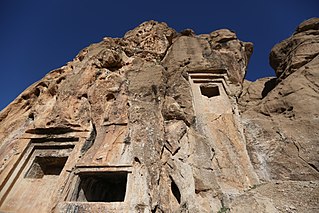
The Essaqwand Rock Tombs are three rock-hewn tombs located 25 km southwest of Harsin in Kermanshah Province, Iran. On top of the middle tomb there is a rock relief of a man with his profile toward the viewers. He is holding his hands in prayers in front of him. There is also a torch and a fire altar in front of him. Behind the fire altar there is another man, holding up something in his hands. The tombs have been attributed to different historical eras including Medes, Achaemenids, Seleucids and Parthians.

The Do-Ashkaft Cave, being a Middle Paleolithic cave site, is located north of Kermanshah, near Taq-e Bostan, Iran about 1,600 m (5,200 ft) above sea level. Its entrance faces south of Meywala Mount, overlooking the national park of Kuhestan. The site was first visited in 1996 by Iranian researchers F. Biglari and S. Heydari-Guran and during the following four years a series of surface surveys were made at one-month intervals, which resulted in a rich collection of Middle Paleolithic lithic artifacts.
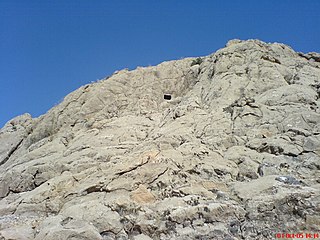
Sorkh Deh chamber tomb is a Shaft and chamber tomb type grave located in Kermanshah Province in Iran. Sorkh Deh in Persian means Red Village. The grave probably dates back 2500 years. Sorkh Deh chamber tomb is located 19 kilometers from another series of historically important chamber tombs of Es-hagh Vand, between Shams Abad and Sorkh Deh villages at the left bank of Gamasiab river.

Ravansar County is in Kermanshah province, Iran, part of what is unofficially referred to as Iranian Kurdistan. Its capital is the city of Ravansar.
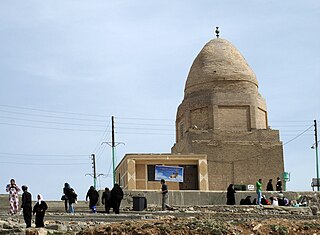
The Tomb of Wais-e Nāzār is a historical mausoleum in Kermanshah, Iran. It is located on the top of a hill, 35 kilometres from the city of Ravansar. The deceased person entombed in the mausoleum is traditionally attributed to be Owais al-Qarani, one of the Tabi'een who died in the Battle of Siffin. It is number 1054 on the list of national monuments of Iran.
The Central District of Kermanshah County is in Kermanshah province, Iran. Its capital is the city of Kermanshah.
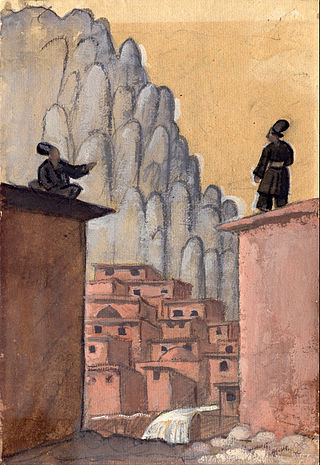
Kerend-e Gharb is a city in the Central District of Dalahu County, Kermanshah province, Iran, serving as capital of both the county and the district.
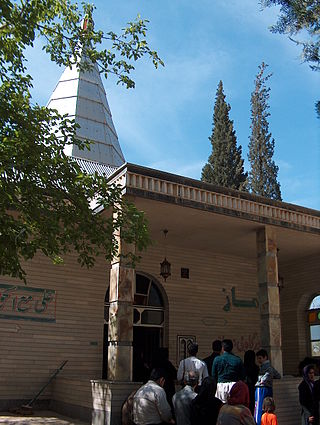
Zardeh is a village in Ban Zardeh Rural District of the Central District of Dalahu County, Kermanshah province, Iran.
Razavar Rural District is in Bilavar District of Kermanshah County, Kermanshah province, Iran. Its capital is the village of Qaleh.
Qaleh is a village in Razavar Rural District of Bilavar District, Kermanshah County, Kermanshah province, Iran, serving as capital of both the district and the rural district.

Hajij-e Bozorg is a village in Sirvan Rural District, Nowsud District, Paveh County, Kermanshah Province, Iran. At the 2006 census, its population was 603, in 163 families.

The Tomb of Ahmad ibn Ishaq is a shrine in Sarpol-e Zahab, Sarpol-e Zahab County, Kermanshah Province, Iran. This shrine belongs to the Shiites and attributed to one of the close companions of Imam Hasan al-Askari, named Ahmad ibn Ishaq Ash'ari Qomi. The tomb of Ahmad Ibn Ishaq is located almost in the center of Sarpol-e Zahab and is considered the most important shrine of this city.
References
Website of CHHTO of Kermanshah
